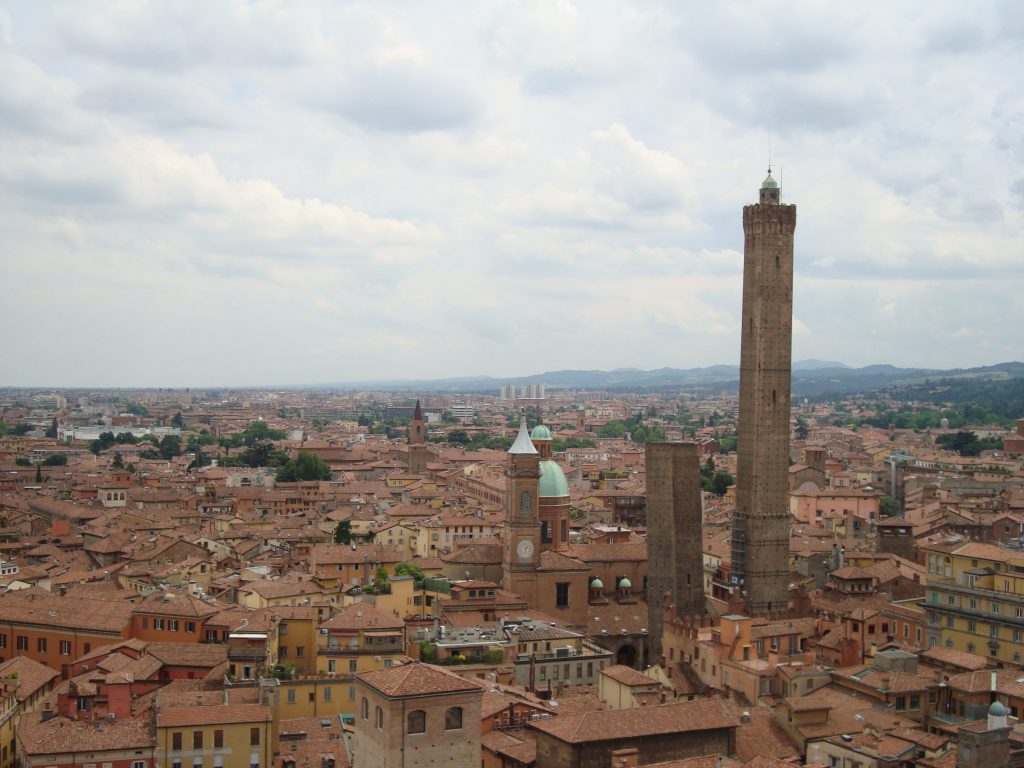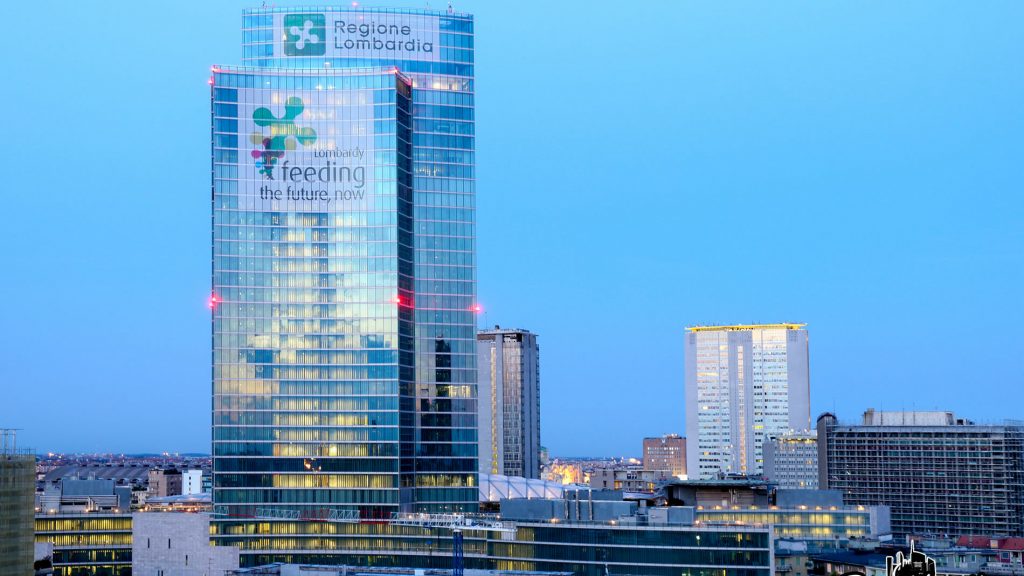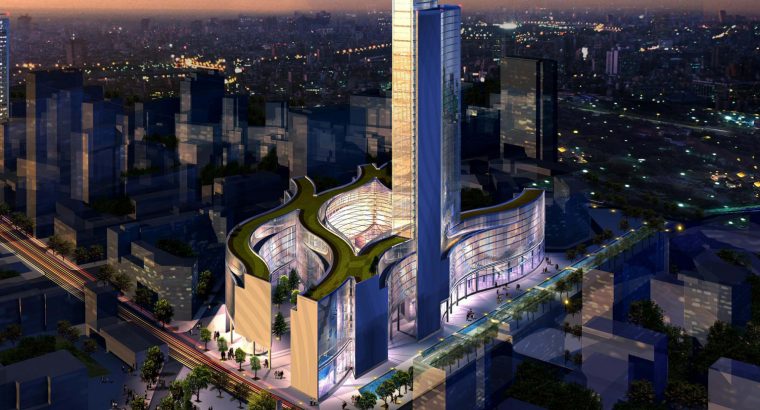Exploring Milano Palazzo Lombardia
Tall Tales and Italy’s Obsession with Height
WARNING: Given that’s there only so much you can say about the various configurations of glass, steel and concrete without running the risk of sounding slightly repetitive, this article takes a roundabout route, starting off with a look at the strange history of tall buildings in Italy. So, if you’d rather not read about a medieval Italian city that resembles New York or a plane crash in Milan that sparked fears of a 9/11-style attack, just skip to the final part, where you can find a description of the undulating structure and soaring tower of the Lombardy Region’s headquarters, located between Stazione Centrale and Garibaldi.
Italy’s Skyscrapers – Going Up in the World
Tall buildings are nothing new in Italy. In fact, the clusters of skyscrapers that we associate with Manhattan – and the “downtown” area or business district of almost every major city these days (including Milan) – can be traced back to Italian medieval and Renaissance cities, such as San Gimignano in Siena, Tuscany. Known as “the City of Fine Towers”, this town saw over 70 tall buildings shoot up into the sky during two centuries of political rivalry between the Guelphs and the Ghibellines (medieval Italy’s version of the US’s ever-bickering Republicans and Democrats). Competing families also attempted to assert their authority with Trump-like towers literally throwing shade over the earthbound mortals below. Bologna’s “twin towers”, constructed by the competing Asinelli and Garisenda families respectively, still dominate the city’s skyline. (By the way, they also both lean, although it’s not exactly a new problem: Dante describes the Garisenda’s disturbing tilt in The Divine Comedy. The tower was partly truncated in the 14th century and just over a week ago the city authorities sealed it off over fears of an imminent collapse.) And as for Pisa’s famously wonky bell tower, let’s not even go there…

Thankfully, these days the advanced engineering and safety features of modern skyscrapers make the prospect of them toppling over extremely remote, although external dangers persist, such as seismic activity or the high winds that led to buttresses being added as afterthought to the Isozaki tower in Milan’s CityLife development. Of course, the possibility remains of being struck by an aeroplane, either deliberately as in the 11th September 2001 attacks on the World Trade Center, or unintentionally: such was (probably) the case when a light aircraft crashed into Milan’s Pirellone tower on 18th April 2002, killing the pilot and two people inside the building.
The obsession with height persists right up to the present era. On 8th May 2009 a highly symbolic ceremony (complete with laser show) took place in Milan. The then-President of the Lombardy Region, Roberto Formigoni, unveiled a stone plaque at the top of the tower, still under construction, of the Region’s new HQ, known as Palazzo Lombardia. The stone (a “pietra di quota”) marked the exact height of the Region’s existing headquarters, the previously-mentioned Pirellone: 127.40 metres. For a brief and glorious period, the Lombardy regional HQ exalted in the title of Italy’s tallest building, reaching the majestic height of 160m. However, in 2011, the Palazzo lost its crown to the surging 231m UniCredit tower designed by Argentinian architect César Pelli.
Palazzo Lombardia

The tower that rises above the Region’s new headquarters is actually a double tower with one side slightly shorter than the other. Both have a concave surface and the whole complex housing the Region’s executive and administrative offices are characterised by sinuous serpentine undulations best seen in aerial photos or satellite images. The complex was designed by Pei Cobb Freed & Partners. The visionary Chinese-American architect IM Pei is most famous for the glass pyramid in the main courtyard of the Louvre. (Its companion, the inverted pyramid, features in The Da Vinci Code.) The curved front of the Palazzo Lombardia sports massive decals relating to the Region and events such as EXPO 2015 and the forthcoming 2026 Winter Olympics.
As with nearly all the new architectural landmarks in Milan, there are public spaces mingling with the more restricted areas. The highlight of the Palazzo is its leaf-shaped covered piazza, which has several shops, cafés and bars. (I once attended a birthday party nearby and remember hurricane-force winds blowing everything off the table: one of the inevitable consequences of building tall.) The Palazzo’s roof is a geodesic net of triangles similar to the new Fiera di Milano in Rho, Norman Foster’s Great Court roof at the British Museum, London and that city’s King’s Cross station.

The main tourist attraction of Palazzo Lombardia, apart from its own architecture, is the Belvedere, a 39th floor gallery where you can get stunning views of the entire city of Milan. It’s open on certain Sundays from 10:00am to 18:00 and is free. (If you plan to visit the Belvedere is essential to check the opening times and dates.) There is also a viewing gallery in the Pirellone, the former headquarters of the Lombardy Region, dedicated to the post-war singer-songwriter and cardiologist (fairly unique combination by any standards), Enzo Jannacci. The Pirellone gallery is only open on special occasions, such as Open House days.
Article by Robert Dennis for Easy Milano
Robert Dennis is a writer and Business English teacher based in Milan. He has been teaching for other 30 years both in the UK and in Italy. A long-time collaborator with John Peter Sloan, Robert published Business English (Gribaudo) in 2020. The book was launched with “Il Sole 24 Ore” and sold in newsstands throughout Italy. Robert has a website for people who want to learn Business English: PayAsYouLearn.com. The site features keywords and phrases, audio and exercises to help professionals improve their language skills. A graduate in English from Oxford University, Robert is a regular contributor to Easy Milano who often writes about plays staged in English in Milan and other cultural events in the city. He is also a translator and “buongustaio” who loves Italian food! robertdennis.it

Featured Image from Regione Lombardia
You must be logged in to post a comment.




